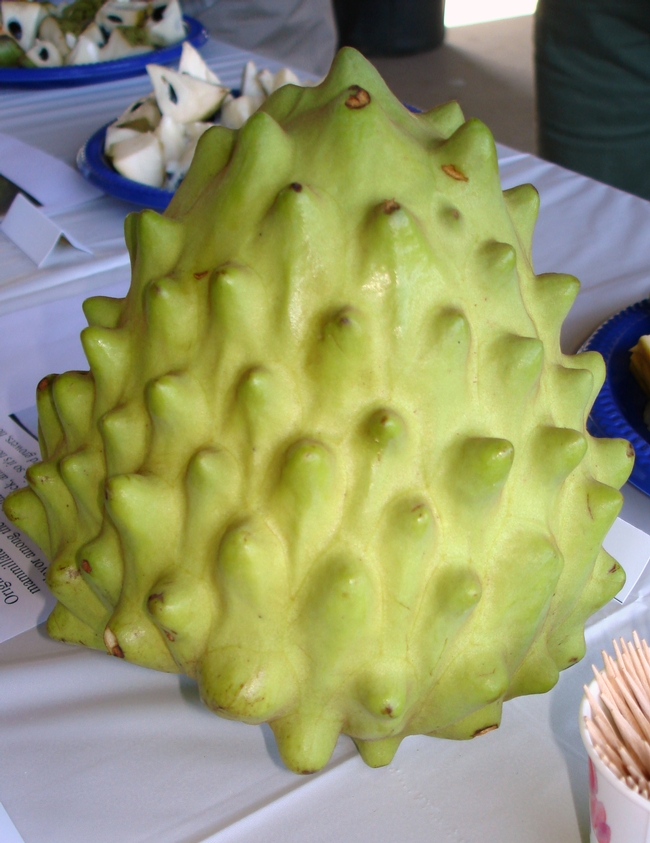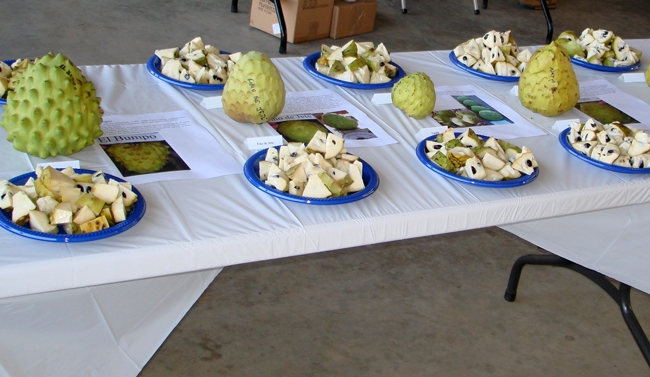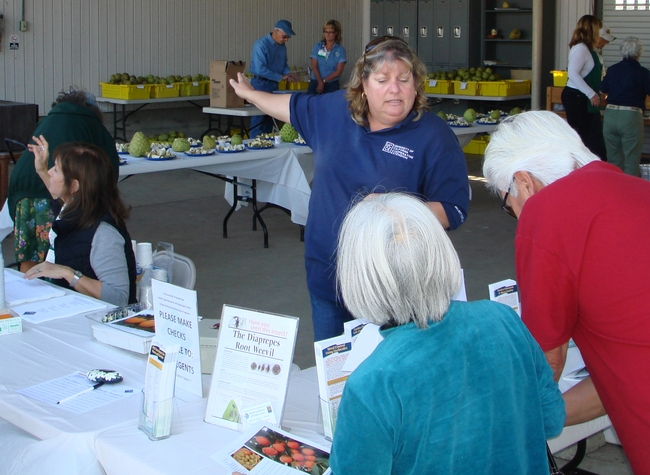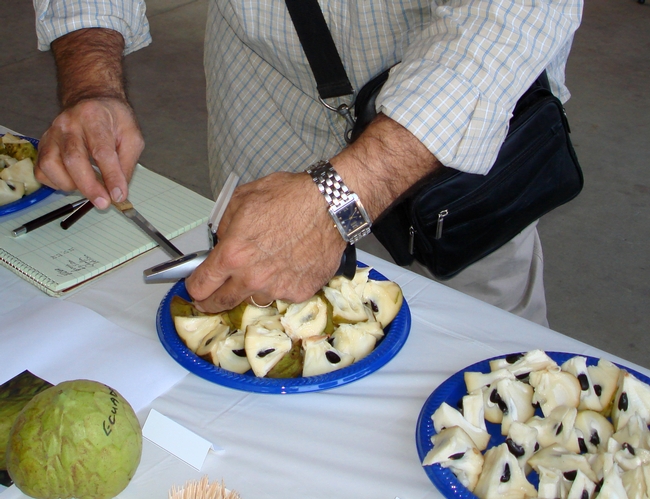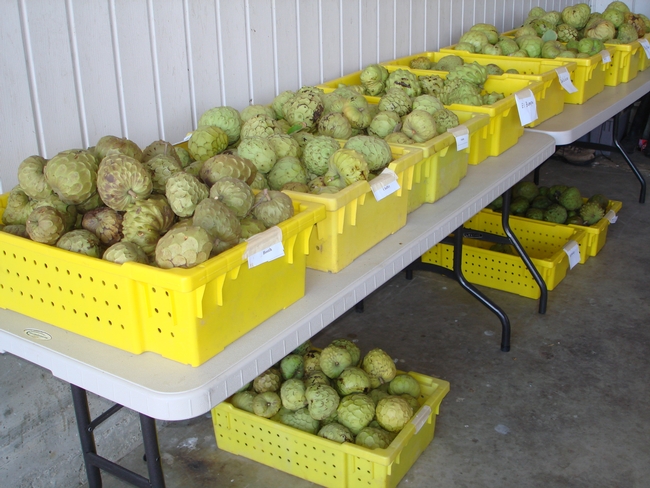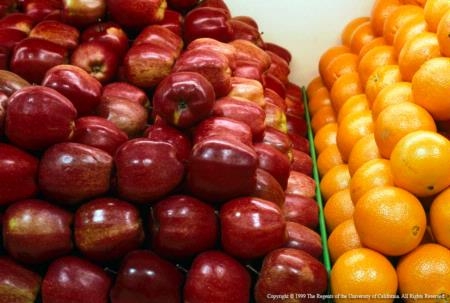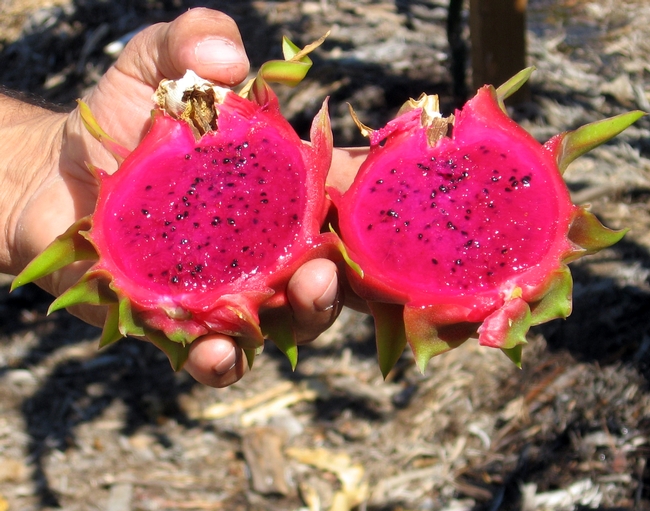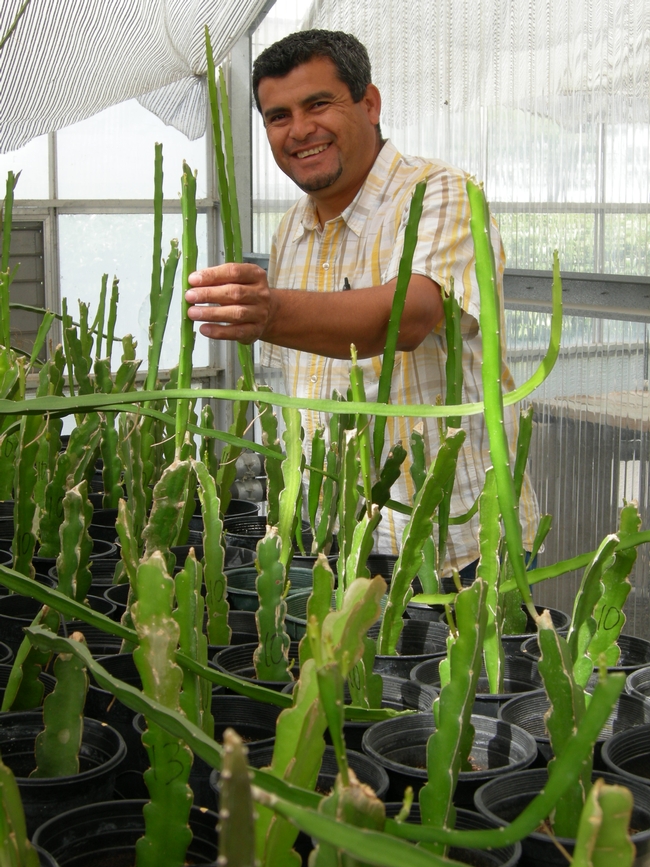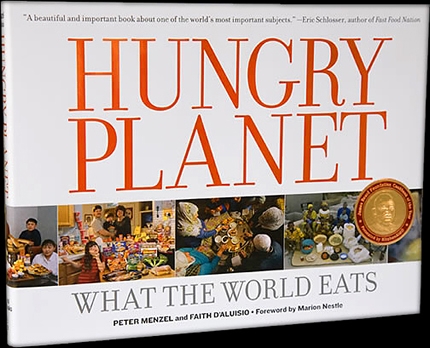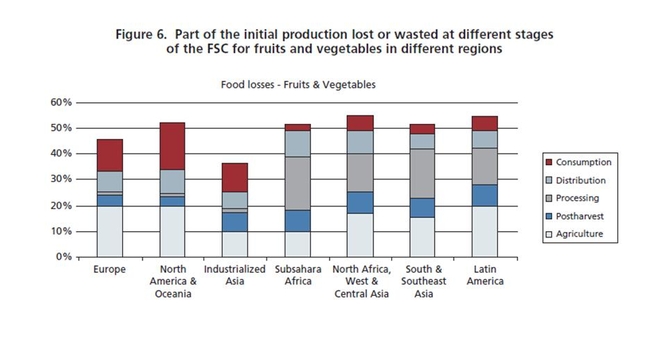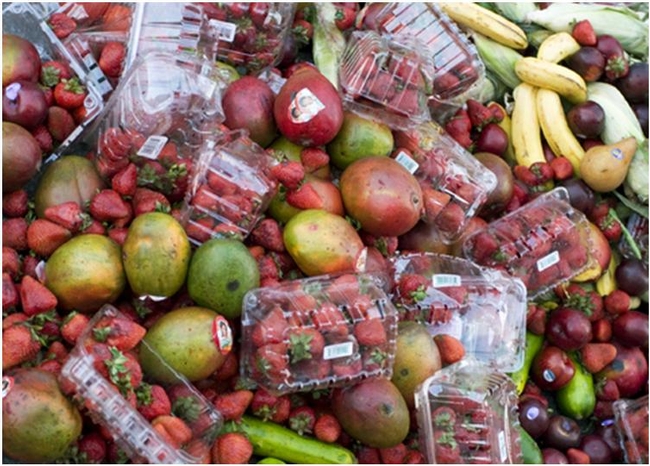Posts Tagged: fruit
Fruit that 'tastes like heaven'
Ever tasted a cherimoya?
Upon first taste, many Californians often argue whether cherimoya tastes like a combination of pear, banana, lemon or other familiar fruits. But Isabel Barkman, UC Master Gardener who grew up eating the subtropical fruit in her native Chile, says that’s not quite right.
“I say it tastes like heaven. The cherimoya tastes like cherimoya. It’s creamy. It’s incredible. Nothing tastes like it,” she said.
On Saturday, she helped organize a tasting of 15 varieties of cherimoya at the UC South Coast Research and Extension Center. About 120 local residents, UC Master Gardeners and members of California Rare Fruit Growers attended. Though “heaven” wasn’t an option, participants were given a scale of 1 to 5 to rate the cherimoya varieties based on exterior attractiveness, texture, flavor and overall quality.
Tammy Majcherek, who works at UC South Coast Research and Extension Center and was in charge of the tasting event, explained that the evaluations will help gardeners and homeowners better know how different varieties grow locally, before they consider planting their own.
The center has small orchards of both cherimoya and persimmon that aren’t being used for research projects, but staff members want to continue maintaining the trees and share them with the public, one way or another.
“Because of budget cuts, we've been trying to figure out ways to keep these collections going or to re-propagate some of the best," Majcherek said. "One of the things that we’re in the midst of planning is an urban horticulture extension project with a demonstration orchard, where the public can come and see the various types of trees that they could grow in this area."
Of the 100 or so cherimoya trees currently planted at the center, the best varieties would be included in the public demonstration orchard – and the results of the taste testing will eventually help staff members select which trees to plant.
The 15 varieties at the tasting were Big Sister, Booth, Chaffey, Deliciosa, Ecuador, El Bumpo, Fino de Jete, Ludica, Nata, Orton, Oxhart, Pierce, Santa Rosa, Selma and Whaley.
“I really love the Big Sister variety because the tree is kind of small and is a heavy producer,” she said. “We had a fruit from Big Sister that was the size of my whole head.”
She said that El Bumpo also produces large fruits. The varieties Fino de Jete and Nata can have excellent flavor, and this year Pierce fruits likely had the highest brix, signifying high sugar levels.
Behind the scenes, preparations for the event included harvesting the fruit more than a week ahead of time so that it would ripen.
“We picked 15 varieties the week before, and it was very stressful. Every day I was there wondering, are they going to be ripe? Are they going to be perfect for Saturday? What if they're too hard? What if they're too soft?” Barkman said. “When the cherimoya ripens, you have about two days to eat it because it will go bad really, really quickly.”
Fortunately the fruit were ripe for Saturday’s event, and extra fruit were available for participants to take home to ripen and share.
Majcherek explained this was the first time the center has organized a tasting event for the cherimoya. She was surprised that so many of the participants already knew about the fruit.
“I think they were mostly coming to the tasting just for the love of cherimoya,” she said. “I had no idea that there was such an interest.”
She plans to hold another tasting event for cherimoya next year, as well as a second tasting event for persimmons in the fall.
For more information, UC Cooperative Extension Ventura County has a page about growing cherimoya commercially and the UC Davis Postharvest Technology Center has recommendations for maintaining postharvest quality of cherimoyas too.
Information about future tastings will be posted to the UC South Coast Research and Extension Center website.
Beyond New Year's resolutions: tips for good health
Oh January 1st, how I hate you. If you’re like me you’re still recovering from the month long holiday food hangover. With three months until spring and swimsuit season on the horizon, you’re feeling the pressure to lose the winter coat! As always, you make that infamous New Year’s resolution: TO LOSE WEIGHT!
“Gym membership here I come!”
“I will not touch another carb for the rest of the year!”
“No sweets ever again… after this one!”
“I’m on a new diet, I eat nothing and when I feel like I’m going to faint I eat a cube of cheese!”
Okay the last one is my favorite quote from the Devil Wear’s Prada, but working in the health field I have found that sometimes people actually think that’s a solution. We find ourselves making resolutions that eliminate entire food groups from our diets, because we think it will help us lose weight. The thing most people don’t know or realize is that sometimes the absolutes we make can be very harmful to our health, and in the long run can actually cause us to gain the weight back plus more.
So this year, let’s make an attainable, realistic goal. Here are three tips selected from www.choosemyplate.gov, to have a healthy year!
- Put a positive spin on it – instead of saying “I can’t eat any sweets at all!” try a few “I will” statements on for size:
- I will add 1 serving of fruits and vegetables to each meal.
- I will make half of my grains whole.
- I will choose water or low-fat milk more often.
- Build a healthy snack – instead of buying the expensive processed snacks, try these healthy tips:
Combine fruit and a dairy food for the morning munchies:
- Apple and cheese
- Banana and yogurt
Combine vegetables and a protein food for a p.m. pick-me-up:
- Celery and peanut butter
- Carrots and almonds
Combining these foods will help you stay fuller longer while increasing your nutrient consumption.
- Don’t discount physical activity – being healthy isn’t about just what you eat. Adults need 30 minutes of physical activity a day and children need 60 minutes. Just because you don’t have a gym membership doesn’t mean you can’t be physically active. Remember that 30 minutes can be broken up throughout the day.
Here are some tips to increase your physical activity incrementally, without breaking the bank:
- Start a walking club with your co-workers, neighbors or friends. You’re more likely to do it if someone keeps you accountable.
- Do what you like! If you hate to run, don’t do it. There’s no use in driving yourself crazy doing something you hate. If you like to dance, then turn the radio up and have fun!
- Do stretches, exercises, or pedal a stationary bike while watching television.
Remember to always consult your physician before beginning a rigorous exercise regimen.
May your new year be full of realistic, attainable, resolutions! Keep it positive. Select healthy snacks that help you stay full longer. Get moving so you have more energy during the day. For more information and health tips visit www.choosemyplate.gov.
Wishing you all a very healthy 2012!
Grapefruit wonder
I have this huge grapefruit tree in my garden. It is at least 30 feet high and just as wide. It must be at least 70 years old and yields hundreds of pounds of grapefruit annually. The variety is an old standard variety called "Marsh." Marsh grapefruit were introduced in Florida in 1860 and it has been in the industry ever since. It is relatively cold hardy variety and has survived many hard freezes here in northern California. Even though our grapefruit tree gives us a lot of fruit and it has a very long harvest period (February to August), I have to say it isn’t the best tasting variety of grapefruit I have ever had. No, that honor would go to some of the more recent grapefruit introductions. There are several hybrid varieties that yield large and very sweet fruit. They are just now beginning to harvest many of these and they will be in your farmers markets and grocers soon. The trees could be in your garden too but I would wait until spring to plant since the young trees can be very susceptible to frost injury.
One of my favorite "grapefruit" varieties is one that is similar to my Marsh but sweeter and has an earlier harvest period. It is a "Cocktail" hybrid. However, it really isn’t a grapefruit at all but rather a hybrid of a mandarin and a sweet pummelo. Its juice and fruit are so sweet and delicious. It does have seeds but the flavor is amazing and truly worth planting in the garden for its wonderful juice as well as for fresh eating. It begins to ripen in January and will hang on the tree through March.
Another great variety with an even earlier harvest period is a grapefruit called "Oro Blanco." Oro Blanco is a hybrid between a white grapefruit and a sweet pummelo and was introduced in 1980. This one is also very sweet, but it is seedless and has a much earlier harvest period, from December to March. The only thing that may be a bit off putting is that it has a greenish yellow rind rather than the bright yellow gold of other varieties. Nonetheless, I find this one to be a winner in my book. In fact, in Citrus Variety Collection Notes at UC Riverside, it says:
"10/1988, EMN: My opinion, for what it might be worth, regarding Oroblanco vs Melogold, is this: For maximum returns as a cash crop, plant your acreage to Melogold; but save one space near your back door for a tree of Oroblanco for your own use."
Melogold is another hybrid and a sister variety to Oro Blanco. It was introduced to the industry in 1986 by the Citrus Research Station at UC Riverside. Melogold is fairly similar to Oro Blanco but the fruit is a bit larger and the rind is more yellow at maturity. Both are winners in my book. For more information on this and other citrus varieties for your garden, read the free online publication "Tried and True or Something New: Selected Citrus Varieties for the Home Gardener."
Now, what can you do with grapefruit besides just eat the fruit or squeeze the juice for breakfast? Well, there is always grapefruit and fennel salad, grapefruit sorbet, grapefruit glaze for fish, grapefruit and pomegranate juice martinis, and one of my favorites this time of year is a cranberry-grapefruit conserve that my mom used to make. Here is the recipe:
Mom’s Cranberry-Grapefruit Conserve
Ingredients:
- One large grapefruit (red or white)
- Water
- 2 1/2 cups sugar
- 1 pound fresh or frozen cranberries
Steps:
- Peel strips of the rind from the grapefruit. Include a small amount of white pith.
- In a medium saucepan, blanch the strips by bringing them to a boil over moderate/high heat. Drain and repeat once more.
- Dice the blanched peels into about ¼ inch pieces; reserve.
- Juice the grapefruit.
- Combine the grapefruit juice, cranberries, 1-1/2 cups of the sugar and 1-1/2 cups of water and bring to a boil. Simmer over low heat, stirring occasionally, until the liquid has reduced by half and the cranberries are cooked down, about 1-1/2 hours.
- In a medium saucepan, mix the diced blanched grapefruit peel with 1 cup of sugar and one cup of water. Bring to a boil and then simmer over moderate heat, stirring occasionally, until the peel is translucent, about 40 minutes. Add the peel and syrup to the cranberry mixture and simmer together over moderate heat, stirring occasionally, until reduced to 3 cups, about 25 minutes. Serve at room temperature or chilled. This conserve can be stored for up to a month in the refrigerator.
Note: I like to pour the slightly warmed conserve over cream cheese to spread on crackers or I also serve it with fish or turkey.
Happy Holidays
You should taste it fresh
Question: What exotic fruit has been named as a flavor in Starburst candy, Ice Breakers gum, SoBe beverages, Vitamin Water drinks, Bacardi rum and even Axe body spray?
Answer: Dragon fruit. (Hylocereus spp.)
So while many of us may have tasted products that flaunt its name, have you ever sunk your teeth into a fresh dragon fruit?
If you want to try one, you may be in luck because now is the peak harvest season in Southern California for this subtropical cactus fruit with the fire-breathing name — also known as pitahaya. And it just so happens that growing and eating fresh dragon fruit is what Ramiro Lobo, UC Cooperative Extension farm advisor for San Diego County and the Small Farm Program, is most interested in.
Lobo says he’s known about pitahaya since he was a kid, but his professional interest was rekindled when the enthusiasm of the Rare Fruit Growers group intersected with an ongoing quest to find crops that are more water-efficient for the region.
“Wherever you can grow Hass avocados, you can grow dragon fruit,” he said. “And it uses less water than avocados or any other orchard crop that we grow in San Diego.”
Though this used to be a fruit found only rarely in specialty stores, Lobo says that is changing.
“We’ve seen the market expanding. We’re seeing it in high-end restaurants in Los Angeles and Las Vegas,” he said. “Supply is very sketchy right now, but growers who are selling direct at farmers markets are getting $7-8 per pound. Hardly any other fruit today is bringing that kind of money.”
One other clue that the U.S. market for this “artichoke from Mars” (as one LA Times writer described it) is expanding? Imports of the fruit have been growing from Vietnam, with perhaps 600 tons imported in 2010. And the USDA is currently working through the processes that could allow imports from Mexico, Thailand and Central America too.
While Lobo doesn’t sound too worried about competing with imported dragon fruit, he does hope your first taste of fresh dragon fruit is indeed very fresh.
“We cannot compete with Vietnam fruit for price, but we can definitely compete for quality,” he said. “The challenge is that a lot of people are exposed to dragon fruit, but the fruit quality is lousy. It’s a very sensitive fruit, so if you put it in a container and send it across the ocean for 10 days, it’s not going to be as good. But people who get exposed to a good variety keep buying it.”
In California, it is estimated that about 200 acres are planted in pitahaya, with anywhere from 400 to 1,000 acres planted nationwide.
Lobo oversees approximately 500 dragon fruit plants at the UC South Coast Research and Extension Center in Irvine. He is currently working to set up an irrigation trial for pitahaya, to better evaluate its water requirements. He is also working to test out different trellis systems, comparing hedge versus orchard systems for this fruiting cactus.
The UC South Coast Research and Extension Center is also where the pitahaya field day was held recently. Lobo said questions from the day’s 100 or so participants sounded like more growers are getting serious about growing pitahaya commercially, with more technical questions and an interest in disease, rodent and pest management.
“The bar has been raised, and [some of those questions] even put us in a bind because without the research, it is kind of hard to answer them,” he said.
In the meantime, Californians and marketing companies will probably continue to find new secondary uses for this fruit’s juice, pulp and name: Lobo says he’s seen wines made with dragon fruit and organic yarn dyed naturally with that fiery pink flesh.
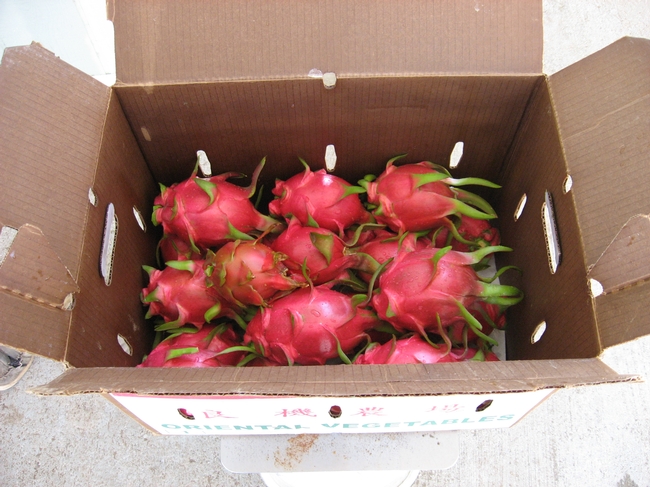
Pitahayas, as packed at a small farm in San Diego. (Photo by Shermain Hardesty)
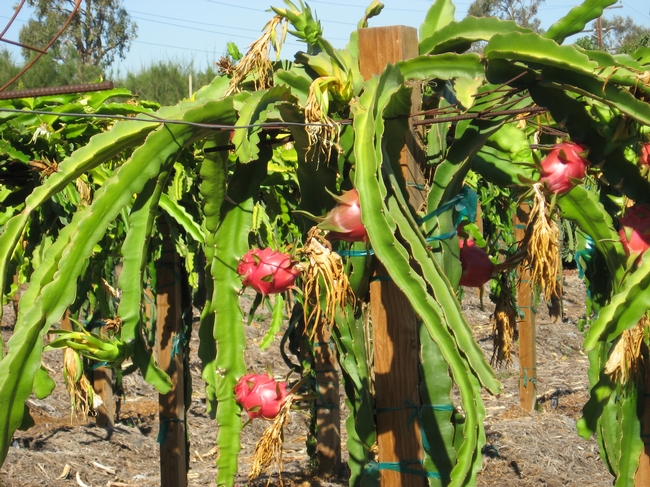
At UC South Coast Research and Extension Center, the dragon fruit plants are currently in an orchard system, though new trellis trials will soon be under way. (Photo by Shermain Hardesty)
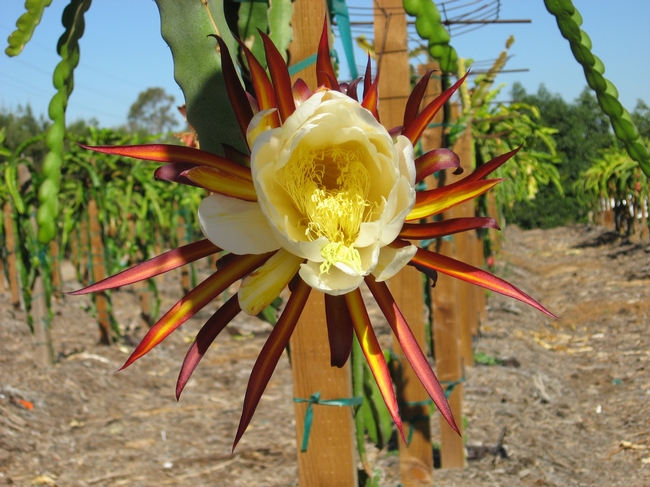
Pitahaya blooms at UC South Coast Research and Extension Center. (Photo by Shermain Hardesty)
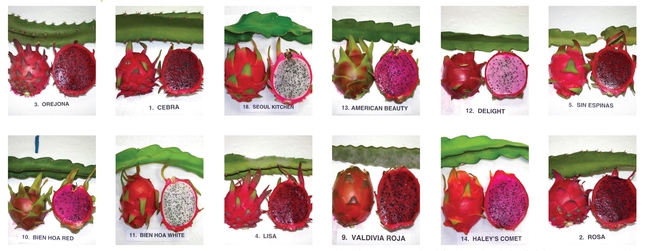
Colors of ripe pitahaya flesh can vary between red, fuschia, pink and white.
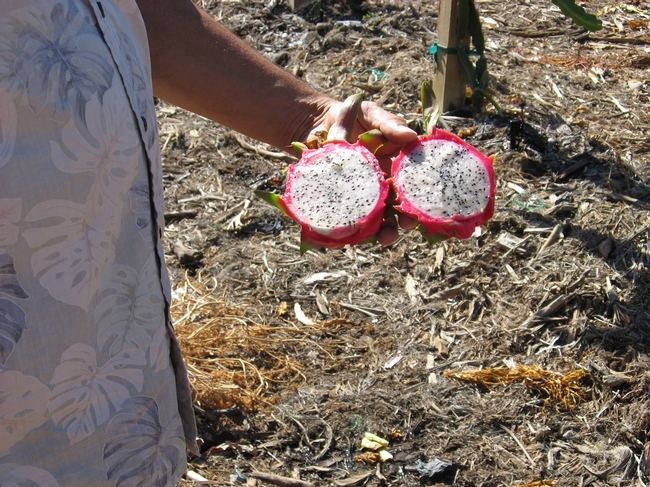
Irvine Field Station white flesh pitahaya
It's just a waste
What got me started on this contribution is a book I recently read, called Hungry Planet by Peter Menzel and Faith D’Aluisio. It photo-chronicles what an average family from different regions around the world eats in a week. Fascinating reading, but not the topic of this blog, just the inspiration.
I’m writing about food waste, specifically fresh fruits and vegetables. First let’s look at the facts. In a 2011 report commissioned by the Food and Agriculture Organization, it was found that “Roughly one third of the food produced in the world for human consumption every year — approximately 1.3 billion tons — gets lost or wasted.”
The report does distinguish between loss and waste, pointing out that losses, which occur in production, harvest, postharvest and processing, are most prevalent in developing countries, whereas waste, which occurs at the end of the processing phase, is due to poor distribution and consumption habits, found in the industrialized countries. In developing countries, 40 percent of losses occur at post-harvest and processing levels while in industrialized countries more than 40 percent of losses happen at retail and consumer levels.
The report also points out that per capita waste by consumers is approximately 10 times greater in Europe and North America than it is in sub-Saharan Africa and South and Southeast Asia. Not surprising, just hard to hear.
We aren’t only wasting food when we throw out our fruits and vegetables. It takes time, money, energy, water and oil to generate produce. In fact, an article written for The Economist states, “Producing these wasted calories accounts for more than one-quarter of America’s consumption of fresh water, and also uses about 300 million barrels of oil a year.”
And, if that’s not enough what about the time and gas required to take it from the farm to the packing house to the shipper to the store to the home to the dump? And once it’s at the dump, rotting fruits and vegetables produce methane, a greenhouse gas 20 times more potent than carbon dioxide.
OK, OK enough with the lecture. What can we do?
- Raise your awareness of waste
- Assess what you have on hand before buying more
- Plan your meals and shop with a list to reduce over-purchasing (and go to the store with a full stomach!)
- Organize your fridge and counter so you know what you have
- Cook so that you don’t have too many leftovers
- Use your freezer
- Get creative with any remaining fruits and vegetables — recipes are abundant online
- Compost leftovers so you can grow your own fruits and vegetables


